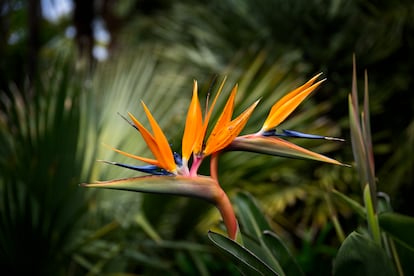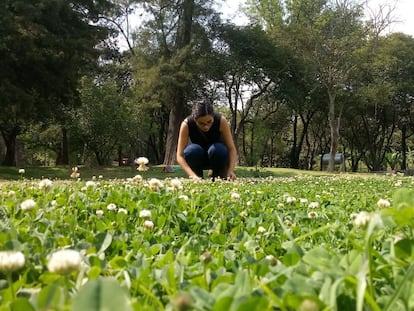Strelitzia, the exotic plant that’s the new favorite of interior decoration
Known as the ‘bird of paradise’ for the shape of its flower, its majestic presence has become ubiquitous in restaurants, hotels, store windows and Instagram

A wicker armchair. A sun mirror. A Scandinavian sideboard. A Balinese style rattan lamp. A vintage demijohn. A ‘bird of paradise’ plant…Just picture it. This sequence describes current trends in interior design, including a living element: the Strelitzia or bird of paradise. In the age of Instagram, the mission of choosing a plant to decorate our homes is inevitably conditioned by the bombardment of photographs of what is trending right now. Movies, ads, restaurants, bars and the best-decorated stores show us images of idyllic plant scenery that make us inevitably lean towards one or another plant species.
Decades ago it was the striped dracaena (Dracaena fragrans) and the Kentia palm (Howea forsteriana). Later came the much-touted Swiss Cheese plant (Monstera deliciosa), mother-in-law’s tongue (Sansevieria trifasciata) and ZZ plant (Zamioculcas zamiifolia). But lately, if there is one plant that has conquered our hearts and homes with its tropical air, it is Strelitzia.
“Ten years ago not one was being sold. In the last three years, demand has skyrocketed,” says Pedro Tabernero, owner of the Flores Madrid flower shop in the capital of Spain. “The boom was unleashed because many interior designers began to use it in the decoration of luxury hotels in the Caribbean, Mexico, the Dominican Republic, the Canary Islands, the Maldives and other tropical destinations. And through magazines and social networks, that trend has moved to Europe,” he explains.
The Strelitzia is a genus native to the tropical and subtropical regions of Africa. With large, intensely green leaves reminiscent of those of the banana tree, it is known as the bird of paradise for its extraordinary flower that resembles a crested bird’s head. “On an aesthetic level, its structure and foliage convey an exotic air that instantly transports us to a paradisiacal beach, making it perfect for injecting any space with the good vibrations of an eternal tropical spring,” says Natalia Sáez Achureando, an architect, landscape designer, book author and blogger.
The genus Strelitzia has five species. The most common in decoration are S. reginae —small in size and with orange flowers— S. nicolai —with white flowers and which, when planted in the ground, can reach up to five meters in height— and S. augusta —the largest, most suitable for outdoor cultivation. “It is important to choose the species that best suits the space of our house,” adds this expert.
Due to the plasticity of its leaves, the elegance of the foreshortenings of its long petioles and its majestic upright posture, Strelitzia nicolai is ideal as a unique plant for interior decoration. Like a designer lamp or a work of art, its irresistible magnetism creates a lush focal point in any space. “I recommend placing it in as spacious a room as possible so that it shows off its large size; I also recommend putting it in a heavy pot to prevent the plant from tipping over when it grows and gains weight and height. A very practical trick is to place the pot on a plate with wheels to facilitate its movement,” continues the landscape designer. As for the flowerpot, the bird of paradise cries out for an ornament to match: “A large terracotta jar, a rattan flowerpot cover or a self-watering flowerpot with modern lines are good options.”
Ragged leaves are one of the attributes that define the unique appeal of Strelitzia. There is no need to fear this beautiful imperfection. “Plants are fascinating beings. In thousands of years of evolution they have modulated their structures to adapt to the environment. The bird of paradise, for example, is very elastic to resist strong gusts of wind without breaking,” explains Sáez. Its leaves crack to cope with the buffeting of rain and wind in their tropical ecosystems of origin. “If the leaves were held as smooth as sails, the plant would be at risk of breaking.” Indoors we tend to see them looking impeccable, but outdoors the torn leaves are part of their charm.
Although it is easy to care for, there are things that must not be omitted to ensure its wellbeing. “The most important thing is to place it in a very bright place where it receives direct sunlight in the morning or filtered light in the afternoon,” says Natalia Sáez on her Instagram profile, where she has almost 110,000 followers. For people who forget to water their plants, it is a very handy choice since it requires the substrate to dry between waterings. Spraying it is another advisable move in dry climates.
In fact, “the bathroom can be a very good place for the bird of paradise thanks to the humidity that accumulates there. But it is essential that it not be a dark bathroom or one without windows, because light is vital”, insists Sáez. In winter it must be protected from the frost. “In the Canary Islands they are used to create hedges on the roads and they grow wild and they are wonderful,” says Pedro Tabernero, indicating that their natural habitat is mild climates. “They also do very well on the Spanish coast, even in [the rainy northwestern region of] Galicia, where the winters are mild and the cold is humid,” he adds. Bear in mind, however, that Streliztias that are kept indoors and in a pot often do not develop flowers.
If the expressiveness of a Strelitzia on its own is hard to beat, in the company of other species it will create an invaluable sensation of color, texture and vitality in any home. One recommendation is to fill corners with compositions of different plants of varying heights.
In terms of price, it is fair to say that the Strelitzia, especially the S. nicolai, is an expensive plant compared to other large species used to decorate indoor spaces. “The price of the plants grows exponentially as their size and, therefore, their age increase,” says Sáez. “A miniature plant costing €4 can reach €50 in a medium size. This is because they are living beings that are difficult to grow. That is why I think that paying €70 or €80 for a specimen of almost two meters is justified.”Such an investment is profitable because “the bigger they are, the more resistant and easier to maintain.”
Sign up for our weekly newsletter to get more English-language news coverage from EL PAÍS USA Edition
Tu suscripción se está usando en otro dispositivo
¿Quieres añadir otro usuario a tu suscripción?
Si continúas leyendo en este dispositivo, no se podrá leer en el otro.
FlechaTu suscripción se está usando en otro dispositivo y solo puedes acceder a EL PAÍS desde un dispositivo a la vez.
Si quieres compartir tu cuenta, cambia tu suscripción a la modalidad Premium, así podrás añadir otro usuario. Cada uno accederá con su propia cuenta de email, lo que os permitirá personalizar vuestra experiencia en EL PAÍS.
¿Tienes una suscripción de empresa? Accede aquí para contratar más cuentas.
En el caso de no saber quién está usando tu cuenta, te recomendamos cambiar tu contraseña aquí.
Si decides continuar compartiendo tu cuenta, este mensaje se mostrará en tu dispositivo y en el de la otra persona que está usando tu cuenta de forma indefinida, afectando a tu experiencia de lectura. Puedes consultar aquí los términos y condiciones de la suscripción digital.
More information
Últimas noticias
Petro claims the ELN was the target of US attack in Venezuela
Maduro counterattacks Trump with rhetoric and announces downing of nine drug trafficking aircraft
‘Ecce Homo’: The miraculous disaster that made a small Spanish town famous
Return to sex testing at the Olympics: IOC edges closer to banning transgender women
Most viewed
- Sinaloa Cartel war is taking its toll on Los Chapitos
- Oona Chaplin: ‘I told James Cameron that I was living in a treehouse and starting a permaculture project with a friend’
- Reinhard Genzel, Nobel laureate in physics: ‘One-minute videos will never give you the truth’
- Why the price of coffee has skyrocketed: from Brazilian plantations to specialty coffee houses
- Silver prices are going crazy: This is what’s fueling the rally










































